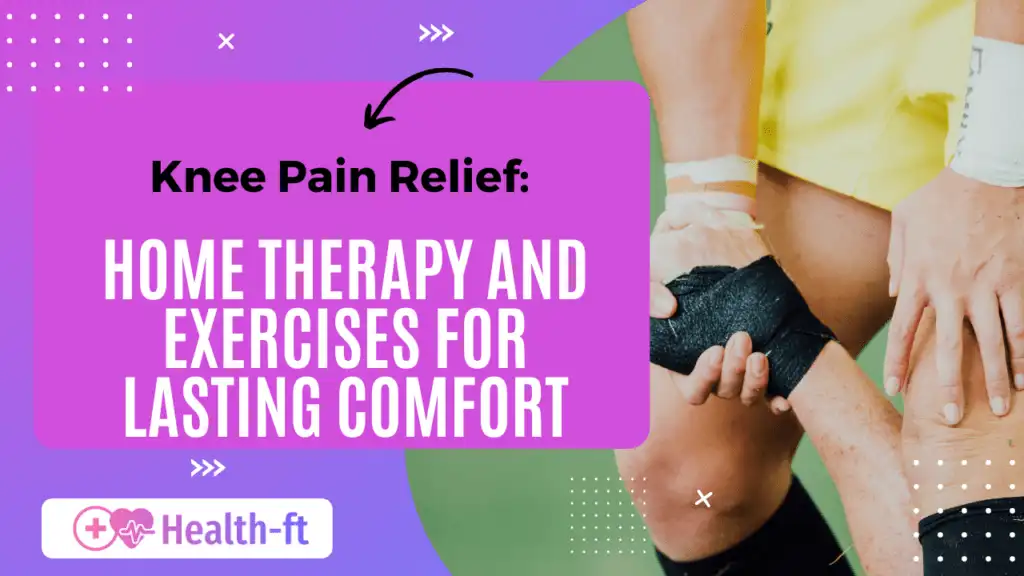Knee pain has become a common issue affecting people of all ages due to factors such as injuries, arthritis, or overuse of the knee joint. If not managed properly, the pain can become severe and restrict daily activities. Fortunately, there are effective knee pain relief exercises and home therapy methods that can help minimize pain and improve joint flexibility.
In this article, we will explore different home therapy techniques and exercises that can provide lasting relief.
What Are the Common Causes of Knee Pain?
Understanding the root cause of knee pain is essential before exploring knee pain treatment without surgery. Some common causes include:
- Arthritis: Osteoarthritis and rheumatoid arthritis can lead to knee pain due to cartilage breakdown.
- Injuries: Ligament tears (such as ACL), meniscus injuries, and tendonitis are common knee problems.
- Overuse: Repetitive movements in athletes and active individuals can lead to chronic knee pain.
- Bursitis: Inflammation of the bursae (fluid-filled sacs around the knee) can cause pain and swelling.
Identifying the cause helps determine the most suitable treatment, but always consult a doctor before starting any new therapy or exercise routine.
What Are the Best Home Therapy Methods for Knee Pain Relief?
Home therapy involves self-care remedies that can be done without professional help. Incorporating knee pain home treatment methods can effectively ease pain and improve mobility.
1. R.I.C.E Therapy
R.I.C.E (Rest, Ice, Compression, Elevation) is a well-known home remedy for acute knee pain.
- Rest: Avoid activities that worsen the pain and give your knee time to heal.
- Ice: Apply an ice pack every 2-3 hours for 15-20 minutes to reduce inflammation.
- Compression: Use an elastic bandage or knee brace to prevent swelling.
- Elevation: Keep your knee elevated above heart level to improve circulation.
2. Heat Therapy
Heat therapy is beneficial for chronic knee pain, such as arthritis-related stiffness.
- Use a heating pad for 15-20 minutes to relax muscles and increase blood flow.
- A warm bath can also help relieve stiffness and improve joint movement.
3. Weight Management
Excess weight adds stress to the knee joint, worsening pain and discomfort. Maintaining a healthy weight through eating nutritious food, proper nutrition and regular physical activity can reduce strain on the knees and promote overall joint health.
What Are the Best Knee Pain Relief Exercises?
Exercise is a key component of knee pain relief, as it strengthens the surrounding muscles, increases flexibility, and improves mobility. Here are some effective exercises:
1. Quadriceps Stretch
Stretching the quadriceps (front thigh muscles) can help alleviate knee pain.
How to do it:
- Stand and hold onto a chair or wall for balance.
- Bend one knee and pull your ankle toward your glutes.
- Hold for 30 seconds and switch legs.
2. Hamstring Stretch
Tight hamstrings can contribute to knee pain, making this stretch beneficial.
How to do it:
- Lie on your back and extend one leg on the floor while bringing the other knee toward your chest.
- Wrap a towel around your raised foot and gently pull it toward you.
- Hold for 30 seconds and switch legs.
3. Leg Raises
Leg raises strengthen the quadriceps without putting stress on the knee joint.
How to do it:
- Lie flat on your back with one knee bent and the other leg straight.
- Lift the straight leg to about 45 degrees and hold for five seconds.
- Lower slowly and repeat 10-15 times per leg.
4. Wall Squats
Wall squats engage the quadriceps, hamstrings, and glutes, supporting knee stability.
How to do it:
- Stand with your back against a wall and slide down into a seated position.
- Hold for 10 seconds, then slowly rise back up.
- Repeat 10 times.
5. Calf Raises
Calf raises strengthen the lower leg muscles, improving knee support.
How to do it:
- Stand with feet shoulder-width apart, using a chair for balance.
- Rise onto the balls of your feet, hold for five seconds, and lower down.
- Repeat 10-15 times.
6. Step-Ups
Step-ups mimic everyday movements, improving knee strength and stability.
How to do it:
- Use a sturdy step or low platform.
- Step up with one foot, bringing the other foot up to join it.
- Step back down and repeat with the opposite leg.
- Do five to ten repetitions per leg.
7. Glute Bridges
Regular glute exercise contributes to knee stability, making them an essential part of a workout routine..
How to do it:
- Lie on your back with your knees bent and feet flat on the floor.
- Press through your heels to lift your hips, creating a straight line from shoulders to knees.
- Hold for five seconds and lower slowly.
- Repeat 10-15 times.
What Additional Tips Can Help with Knee Pain Relief?
Besides therapy and exercise, these lifestyle adjustments can help manage knee pain and also prevent issues like lower back pain, which is often linked to poor posture and weak muscles.
Low-Impact Activities
Swimming, cycling, and yoga keep you active without putting too much strain on your knees.
Supportive Footwear
Shoes with proper arch support reduce knee stress and discomfort. Avoid high heels and poorly cushioned footwear.
Joint Supplements
Some over-the-counter supplements, like glucosamine and chondroitin, may help improve joint health and reduce stiffness.
Foam Rolling
Using a foam roller on the quadriceps, hamstrings, and calves can ease muscle tightness that contributes to knee pain in ladies and men alike.
When Should You See a Doctor for Knee Pain?
While many knee pain issues can be managed at home, medical attention is necessary if you experience:
- Severe pain or swelling that lasts more than 72 hours.
- Inability to bear weight on the knee.
- Noticeable knee deformity.
- Redness, warmth, or fever, which may indicate an infection.
Conclusion
Knee pain relief is achievable with the right combination of home therapy and knee pain relief exercises. By incorporating simple remedies such as R.I.C.E therapy, heat therapy, and weight management, you can reduce pain and improve joint flexibility.
Regular stretching and strengthening exercises help prevent further discomfort, ensuring long-term knee health. If you suffer from chronic knee pain or a past injury, consult a healthcare professional before starting any new treatment.




